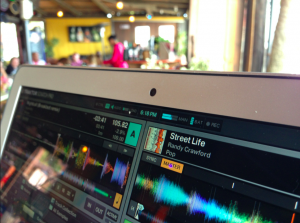
OK, the title’s just a bit misleading. I’ve been using Traktor in my job as a DJ tech writer and editor for nearly ten years, ever since a UK magazine I worked for (IDJ) asked me to review some early controllers that used it. But back then the software I finally personally settled on for my first forays into digital DJing wasn’t Traktor, but Virtual DJ (parallel waveforms, y’see). Later, I used Serato ITCH for all my personal DJing gigs. But a couple of things have recently persuaded me to switch to Traktor for a while in my own DJing – for the first time.
Reason number one? Here at Digital DJ Tips, we’re in the middle of a six-month planning, filming and post-production cycle for “Pro Digital DJ”, our next DJ course. Naturally in the course we go into a lot of depth about all the major DJ software programs, Traktor included. Trouble was, I’d never DJed professionally with Traktor, and I realised right at the start of planning for Pro Digital DJ that I had to fix that.
But secondly, I have to say fallen in love with Traktor DJ – the iPhone/iPad version of the software. It’s massively fun. One of its benefits is that it has metadata sync with “big” Traktor, so you can do your beatgridding and cue point setting “on the fly”, via a simple Dropbox data sync. (Note, it syncs the metadata, not the tracks themselves – something a lot of readers have been confused about.) Sounds like a massive time-saver to me, time being something I have precious little of to spare.
So it was time to give Traktor a go. And my first gig with it was last night. Here’s how I prepared, how it went, and my initial thoughts.
Getting prepared
As Dropbox sync was one of the things that attracted me to doing this, I thought I’d set that up first. With my collection mirrored via USB across iPad and iPhone from the MacBook, I booted up Traktor on the MacBook and hit the Dropbox sync. In typical “let’s make this sound complicated” NI style, I was told a few things I didn’t understand, and given a very official-looking string of alphanumeric numbers via an alert box that confirmed that it was all synced up. Great stuff – a quick check on the iPhone and the cue points and beatgrids did indeed seem to all be there.
My next job was to import my music, and having changed the “Music-Library” default destination in the (famously intimidating) Traktor config panel to my iTunes library, it all arrived. I play a lot of downtempo so I made some tweaks to the analysis options (so it would pick up music as low as 68BPM), and let it do its thing.
There were a couple of trip-ups (Traktor didn’t like the cover art size on a couple of tunes, it “couldn’t delete the transients” – eek! – when I removed the stock samples etc from the collection that I knew I wouldn’t be needing), but overall all looked good.
I loved the accuracy and efficiency of the built-in key analysis. This is huge because it is one step fewer to undertake. If you know Traktor is going to analyse the key of your new tunes, you can bung them into iTunes right off, change a few tags (genre, normally), sort them into playlists and as long as Traktor is set to auto-import on load, you know they’ll be there and get key analysed automatically.
Ah, iTunes playlists. This is my first big bugbear. I want Traktor to let me play out of my iTunes playlists as if I were using the Traktor-imported list of the tunes. It won’t. There’s no key column, no cover art, no ability to edit ID3 tags inline (to correct mistakes, add comments etc as you go along). In other words, it’s a poorer experience than it needs to be.
There is to my mind absolutely no technical reason why the designers can’t go the extra mile like Serato has, for instance, and let you do this. Why does it matter so much? Because iTunes playlists work! They’re “smart”. It’s a natural place to arrange your music away from Traktor, which is why many DJs do. And I’m sure like others, I want to be able to DJ from those playlists when I arrive in my DJ software without being penalised for my choice.
OK, gripe over (solution for now? Copy the playlists I’m interested in over to self-made Traktor playlists). Next job was to make some tweaks. Simplifications, to be honest. I decided that for my first Traktor gig I was going to do zero fancy stuff. I just wanted to finish the gig without mess-ups. So two decks, no FX even, definitely no samples.
I like the way you can have layout configurations and switch between them in Traktor. I set up a simple “two full track decks plus browser” view. No mixer. I turned the waveforms to the full-coloured “Spectrum” look that is close to (but not quite as good as) the waveform displays in Serato that I’m used to, and zoomed them in a bit, and that was it – at least for now. This set-up meant I could see lots of tunes in the library, unlike with some of the more complex layouts, where on a Macbook 13″ screen, you get room for just a paltry couple of actual library tracks to display.

I chose to DJ using a Kontrol S4, which is easy to set up – it really is plug and play. I know from experience that third-party control with Traktor is never as simple as this, and can be downright infuriating, but I have to say with NI’s own hardware, it took zero time.
Also, if you pull the USB out, Traktor carries on playing after a few seconds in your internal sound card, and when you plug the S4 back in, again after a short pause, it takes over again as if you hadn’t done anything – this is reassuring to know, especially if someone accidentally yanks your USB out at a gig. Some software doesn’t fare so well when you do this rather drastic stress test.
Of course, I went through every window in the configuration panel, just to tweak other bits and pieces to my liking, and as I am very familiar with the software already from countless reviews, it was a quick job to spot the bits and pieces that interested me. Then it was all about firing it up and DJing a test half-hour at home to make sure there was nothing to trip me up at the gig. All seemed good, so I packed it all away in a huge Magma bag (thanks for the loan, Steve!) and headed down to the beach bar where I was booked to do my beloved Sunday sunset shift…
Playing the gig
So I guess this section is going to be about my experience DJing on a Traktor Kontrol S4 with Traktor 2.6.1, as obviously the controller is just as important as the software in this circumstance. Overall, it was fine. I enjoyed the gig and only made a couple of mistakes due to the hardware.
What I absolutely loved about the S4 were two things: The looping with a two-digit LED to tell you how many beats you were repeating (massively intuitive), and the big fat filters under the channels, which I ended up using loads. These two things alone made mixing a lot of fun, saved lots of glancing at the screen, and improved my performance.

I found the S4’s lighting to be too dim in daylight, even with the power cable (you can’t use the S4 with a Macbook Air anyway on just USB power; the Macbook Air says it is drawing too much power and disables it). While some lights were fine, I couldn’t see the cue button lighting at all, for instance. However, it wasn’t a big issue when DJing with just two decks, as it’s pretty obvious which one you’re listening to at any time in your headphones. And of course, most DJs play at night…
The S4’s pitch faders can be used in “relative” or “absolute” mode. Relative mode treats where the fader is as the starting point for any pitch adjustments, while absolute mode treats the centre-click as +/-0%. This caught me out when trying to subtly adjust the pitch on a tune that was playing a long way from its true pitch, as the tune suddenly dropped a noticeable few BPMs as soon as I touched the fader. I soon learned and set it to “relative”…
I found the ability to adjust individual gain settings worked fine with the small per-channel VU meters, although I would have liked the S4’s gain controls to be proper knobs instead of infinity encoders, so I could tell at a glance where the gain was set. Gain staging was fine, though, once I’d got used to this.
As regards the software, again it was overall a positive experience, and I pulled off a good set while forgetting the program at times – always a good sign. I liked the fact that there are small magnifying glasses by the “BPM”, “Genre”, “Artist” and “Key” columns, that when clicked return for you other songs with similar attributes. It’s not quite the all-encompassing “recommended next tune” feature from Traktor DJ, but it’s useful nonetheless.
There were a few irks, though. I don’t like how for some reason even with Quantize and Snap turned off, when you’re in Tempo Sync (the least drastic of the two sync modes), the software still seems to do some kind of timing sync when you’re dropping a track in – the only way out of this is to drop it in using the jogwheel instead of the transport controls, or turn sync off entirely.
One way I like to DJ is to use the sync as basically a shortcut for setting the BPM with the pitch faders, but this seeming insistence of the software to match initial beats made that an imperfect process. I am not sure why that would happen, and admittedly it would probably only annoy “old school” DJs like me – but for me, when I press “start”, I want to track to start immediately, not when the software decides. The workaround is to turn off sync – but why doesn’t turning off Quantize / Snap sort this, I wonder?
But my biggest bugbear? It’s that beatgridding isn’t “elastic”. This means that Traktor is still best suited to for DJs who play music recorded at a uniform tempo, which means electronic music; something I find frustratingly limiting. This surely has to get changed at some point; the ability to beatgrid funk, disco, and other live-played dance music is an area where Traktor currently lags behind software including Serato, MixVibes and Ableton.
Overall though, despite only using a small amount of the program’s overall capability, I have to say I was pleasantly surprised. Far from not wanting to continue my experiment, I am now looking forward to investigating some of Traktor’s more powerful features in future practice sessions and gigs.

What’s next…
I want to work on some default FX settings. For now I think I’ll have three single effects so I can use them without even glancing at the screen – a gater, some kind of delay and a “musical” effect like a flanger I think would be good. I definitely want to start learning some keyboard shortcuts, as there are things I’d like to know how to do (some library manipulation, for instance) that should make controlling the program easier that it is now. Might have to map them myself too if I can’t find what I want.
I’m going to look more closely at cues and loops, and as I’ve already done some prep work exploring the functions of the Kontrol F1, the idea of bringing that into the set-up at some point is exciting. And I’m definitely going to do some more investigation into the exact workings of the sync function. There may well be something I’m missing there that corrects the issues I had. I hope so.
So against other software? Well, against Virtual DJ, I think Traktor looks a lot nicer, and the tight integration with the S4 is a definite advantage; the jogs work better than any Virtual DJ jogwheel integration, for instance. Virtual DJ has parallel waveforms though, and video, something Traktor can’t compete with. Against Serato, integration isn’t so much of an advantage, as Serato is tightly integrated with all controllers it works with, and also it’s pretty much personal choice as to which program you think looks nicer – I like them both.
Traktor brings the iTunes rating column over (something Serato doesn’t do), but its library overall is a poorer experience than Serato’s. I like the fact that you can DJ with Traktor using just a laptop, ie no controllers, though; Serato’s “offline” mode I now realise is quite limiting. Serato lacks key detection, although Traktor lacks “elastic beatgridding”.
There are first thoughts; as always, the software that is ultimately best for you depends on what you want it to do, as all the main programs do have differing strengths and weaknesses. Looking to the future, I think it’s only a matter of time before some of the features of Traktor DJ are moved over to “big” Traktor – so if my hunch is right, the coming year will be an interesting one for Traktor software. I’m looking forward to continuing to (finally) get properly up to speed with the software now, so I’m in an even better position to report fully should these things happen. Traktor 3 just around the corner, anyone?
Have you made the switch to Traktor from other software? What did you like or not like? Or, have you made a switch away from Traktor – and if so, why? Please share your thoughts in the comments.








